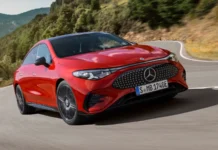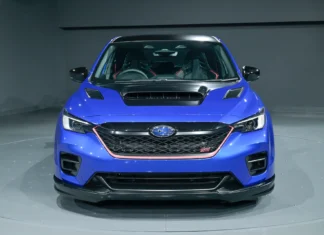
The 2013 Chevrolet Malibu seems to be walking a line between being a mainstream American sedan and a higher-class European four-door. Chevy calls the Malibu its “first global midsize sedan.”
Indeed, Chevy says in promotional material that the new Malibu will be at home (in various forms) from New York to Sydney and Shanghai to Sao Paulo. Or to “nearly 100 markets on 6 continents.”
The front-drive Malibu is no head-turner but is handsome enough to matter what it is sold. It has an integrated rear spoiler and low .29 drag coefficient to cheat wind resistance and noise. Chevy says it is the most aerodynamic Malibu ever. Indeed, the interior is very quiet. However, the low front end, which helps aerodynamics, can be damaged by curbs and other such objects.
The new car looks more aggressive. Its wheelbase is shorter than its predecessor’s, but it has front and rear tracks that are 2 inches wider for a more athletic stance and improved handling. Chrome-tipped exhaust outlets complete the package.
 An all-new interior has a dual-cockpit layout, somewhat resembling those in classic Corvettes. Backlit gauges are a snap to read quickly in bright sunlight, and ice-blue lighting on the center stack dials looks nifty at night. The speedometer has both regular and digital readouts.
An all-new interior has a dual-cockpit layout, somewhat resembling those in classic Corvettes. Backlit gauges are a snap to read quickly in bright sunlight, and ice-blue lighting on the center stack dials looks nifty at night. The speedometer has both regular and digital readouts.
Climate controls are large. Some secondary controls are small, although not too difficult to use. The console has handy cupholders with a cover, and front doors have roomy storage areas.
But the front seats need more side-support when moving through curves, and the backseat room is rather tight behind the driver. The center of the rear seat is too stiff for comfort and best left to the fold-down armrest with twin cupholders.
The new Malibu is sold in LS, LT and top-line LTZ form, along with the fuel-efficient “Eco” model, which has a projected range of 580 miles. Prices range from $22,390 for the LS model to $27,830 for the LTZ.
 I tested the well-equipped LTZ, which has such items as 7-inch color touch screen radio, dual-zone air conditioning with automatic climate control, power heated front leather-trimmed seats, upgraded audio system and a remote engine start.
I tested the well-equipped LTZ, which has such items as 7-inch color touch screen radio, dual-zone air conditioning with automatic climate control, power heated front leather-trimmed seats, upgraded audio system and a remote engine start.
But all Malibus have a good amount of equipment. The LS items include an AM/FM/CD sound system, audio controls on an adjustable wheel, MyLink in-car infotainment system and power door locks with keyless entry. It also has power mirrors and windows, along with 60-series tires on 16-inch wheels.
Safety items include eight air bags, including side-curtain air bags and front knee air bags.
Malibu options, depending on the model, include a power sunroof, upgraded audio system, leather package, navigation package, electronics and entertainment package, lane departure warning system with forward collision alert, keyles push-button engine start and a rear-vision camera system for parking assist.
 The new Malibu has a more rigid chassis, which contributes to its “Euro-influenced” roadability. An all-independent suspension has a new ride and handling package. The LTZ is the best-handling Malibu, thanks to with standard lower-profile 50-series tires on 18-inch wheels. (Optional are 19-inch wheels.)
The new Malibu has a more rigid chassis, which contributes to its “Euro-influenced” roadability. An all-independent suspension has a new ride and handling package. The LTZ is the best-handling Malibu, thanks to with standard lower-profile 50-series tires on 18-inch wheels. (Optional are 19-inch wheels.)
My agile test car’s ride was comfortable. A standard electronic stability control system briefly cut in almost without notice during a spirited drive down a highway on-ramp with a tricky decreasing radius curve. While moderately heavy, the fuel-saving electric power steering can quickly avoid obstacles. The all-disc brake system with a brake-assist feature is controlled by an easily modulated pedal.
The new Malibu has given up its V-6 in favor of three four-cylinder engines with dual overhead camshafts, direct fuel injection, 16 valves and continuously variable valve timing.
You need all that stuff to get decent power from the 2.5-liter 197-horsepower, 2-liter turbocharged 259 horsepower and fuel-stingy 2.4-liter “Eco” 182 horsepower engines.
The 197-horsepower engine in my test Malibu LTZ provided just average 65-75 passing times. Opt for the turbo engine if you’re often in a hurry.
The “Eco” engine, which has a mild hybrid electronic assist system that shuts off and restarts the engine when it normally would be idling, delivers the best estimated fuel economy: 25 city and 37 highway.
My test 197-horsepower Malibu provided an estimated 22 city and 34 highway. No figures are available yet for the powerhouse 259-horsepower engine.
 Chevy says regular-grade fuel is fine for the “Eco” and 197-horsepower engine, but recommends premium gasoline for the turbocharged engine.
Chevy says regular-grade fuel is fine for the “Eco” and 197-horsepower engine, but recommends premium gasoline for the turbocharged engine.
All work with a six-speed automatic transmission so Chevy can get the most punch and fuel economy from it. The automatic shifts smoothly and has a manual-shift feature. But—oddly—small “plus” or “minus” symbols atop the shifter knob are used in the transmission’s manual mode for upshifts and downshifts.
The large trunk has a wide opening but rather high opening. Rear seatbacks flip forward and sit flat to significantly increase the cargo area, although the pass-through area between the trunk and backseat area is only moderately large.
The trunk lid uses conventional hinges, but the hood glides up via a hydraulic strut. Some fluid-filler areas are at the rear of the engine compartment, but aren’t hard to reach because the compartment isn’t filled with a big engine and its accessories.
The Malibu is up against very stiff competition, including the Ford Fusion, Toyota Camry, Honda Accord, Nissan Altima and Hyundai Sonata.
– Buy it
– Lease it
– Rent it or
-Forget it
I recommend that you Buy It!
Price: $22,390-$27,830
 Dan Jedlicka joined the Chicago Sun-Times in February 1968 as a business news reporter and was named auto editor later that year. He has reviewed more than 4,000 new vehicles for the Sun-Times–far more than any newspaper auto writer in the country. Jedlicka also reviewed vehicles for Microsoft Corp.’s MSN Autos Internet site from January, 1996, to June, 2008. For more of Dan’s thoughtful and insightful reviews please visit his web site HERE.
Dan Jedlicka joined the Chicago Sun-Times in February 1968 as a business news reporter and was named auto editor later that year. He has reviewed more than 4,000 new vehicles for the Sun-Times–far more than any newspaper auto writer in the country. Jedlicka also reviewed vehicles for Microsoft Corp.’s MSN Autos Internet site from January, 1996, to June, 2008. For more of Dan’s thoughtful and insightful reviews please visit his web site HERE.
























